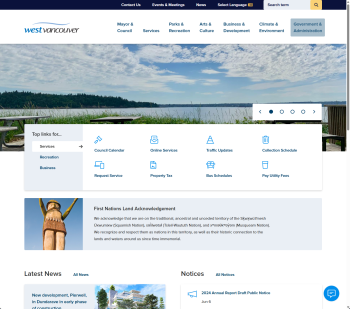West Vancouver
Overview
The District of West Vancouver is a coastal-mountain municipality on Metro Vancouver’s North Shore. Covering nearly 87 km², it blends natural beauty—28 km of shoreline, trails, parks—with mature residential neighbourhoods, community amenities, and efficient municipal services.
History & Development
- Originating as a summer destination in the late 19th century, the area formalized municipally on March 15, 1912. Growth increased with infrastructure like the Lions Gate Bridge (1937–38) and development of communities such as Ambleside and Dundarave.
- Subsequent planning policies discouraged industrial growth, preserving the district’s residential character and large lot zoning.
Governance & Civic Engagement
- West Vancouver operates under a mayor–council / manager system. The council (mayor + six councillors) sets policy, oversees budgets, bylaws, community planning, and ethics commitments.
- Core priorities include fiscal responsibility, transparency, public consultation (e.g. ~630 responses to Housing Needs survey in 2025), and Truth & Reconciliation efforts.
Community Planning & Services
- An ongoing Official Community Plan refresh addresses housing needs, environmental protection, arts/culture facilities, and infrastructure improvements. Engagement has been substantial, indicating active public interest.
- The district offers comprehensive services: property tax, utilities, online permitting, traffic updates, waste management, and recreation programming across parks, pools, fitness, seniors, arts, and business licensing.
Demographics & Profile
- Population estimated around 46,358 (2023), high average household wealth, diverse demographics with growing ethnic representation from Asia, Middle East, Europe.
- Residents benefit from proximity to key destinations: Horseshoe Bay ferry terminal, Cypress Provincial Park, and easy access to Vancouver Island and Whistler via Highway 99.
Verdict
West Vancouver delivers exceptional living with premium natural and civic amenities, backed by structured governance and proactive community engagement. It maintains a balance between environmental preservation and urban planning. Stakeholders should monitor the outcomes of housing policy updates and parking strategies to ensure alignment with regional equity and sustainability goals.

